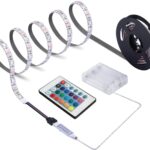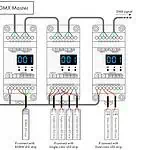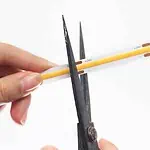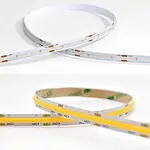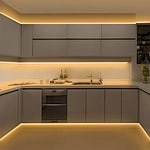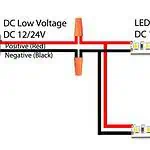Is your LED strip installation area not supporting a plugin system? Or do you need a portable solution for an LED strip that doesn’t need a plug? If yes, this article is for you.
LED strips support versatile power sources. Besides traditional plug systems, you will also find battery-powered solar panels, power bank options, and more. Besides, USB-powered LED strips are also available. You can connect them to your PC or TV without any plug. There is also the possibility to use your car’s battery to glow LED strips using an inverter. But you should know the correct procedure to implement all these methods. It may cause issues like voltage drop, short circuit, or permanent damage if not.
Therefore, I bought you nine amazing ways to use LED strips without plugs here. Check them out-
Can LED Strip Lights Work Without Plug?
LED strips require a power source to function. In most cases, this power is provided via a plug. Nevertheless, LED strips can also work without a plug. But how? LED strips usually operate under low-voltage, 5V, 12V, or 24V. If you use the main power supply directly to the low-voltage LED strips, they will burn out. So, how does the plugged one work?
The low-voltage LED strips that come with plugs have a driver or transformer that converts the high-voltage of the mains to low-voltage that is suitable for LED strips. You can replace the plug and the driver with a battery pack, which will work fine! But now you may question why you use a battery pack when plugs can provide constant power from the main source.
LED strip lights with plugs will not work in places where there is no facility for plug sockets. Again, sometimes, it becomes impractical to drill furniture and set plugin systems. In this case, a battery-packed or plugin alternative power source is required for the LED strip. The battery pack is also easy to hide behind the furniture. However, the battery has a limited lifespan, which brings recharging or battery replacement hassles. But you will not face these problems with a plug.
9 Ways To Use LED Strip Lights Without Plug
No worries if you don’t want to use LED strips with a plug. I have listed nine ways to use LED strips without plugs; check them out:
1. Utilizing USB-Powered LED Strips
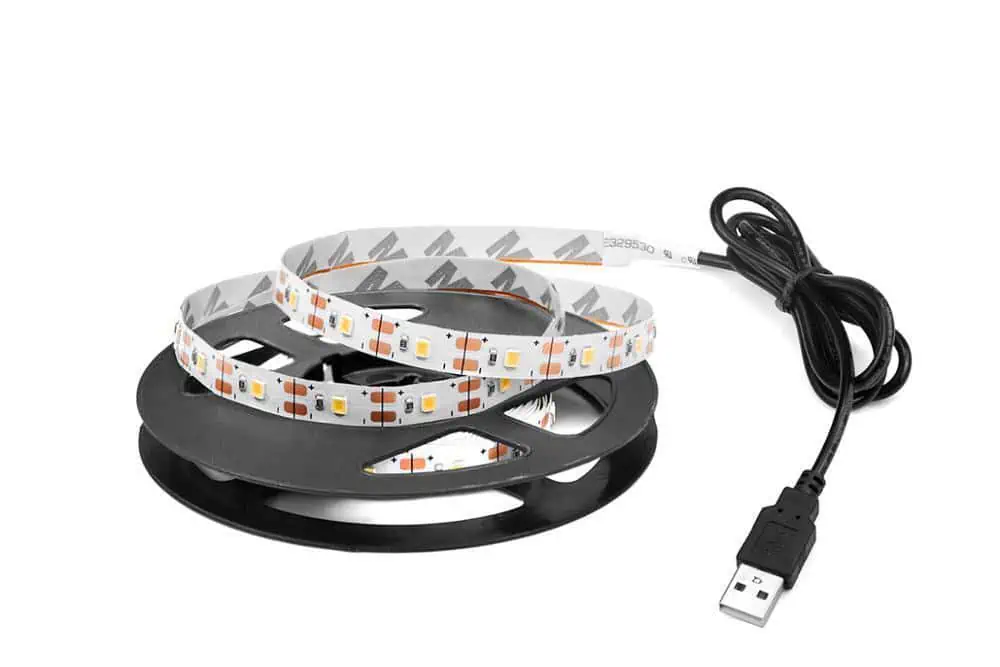
USB-powered LED strips run on low-voltage (5V) that match the volt rating of your smartphone or computer. You can find these strips easily from light markets or online. In addition to the USB LED strip, you will also require a USB cable with the appropriate connector. This can be a micro USB, mini USB, or even a lightning connector, depending on your LED strip type.
2. Employ Power Banks
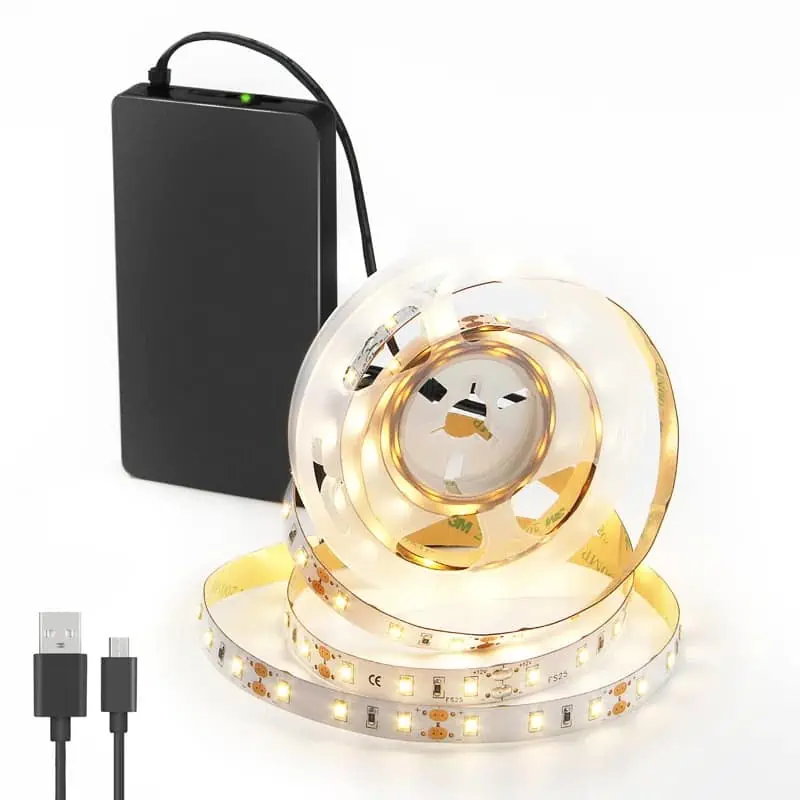
Looking for a portable power source for LED strips? Power bank is your go-to choice. By choosing a power bank as your LED strip power source, you will not need to worry about the plugin hassles. Thus, you can use LED strips indoors and outdoors anytime without looking for a plug socket. You only need to charge the power bank, connecting it to the wall plug via a USB cable. Then, when you need it, remove the bank from the charging and connect it to the LED strip; it’s ready to glow!
3. Stick Your Strip Light To a Solar Panel
When it comes to using renewable energy, solar energy is what hits your mind at first. So, if you want an alternative option to use LED strips without a plug, solar energy is your ideal choice. Connect your LED strip with a solar panel and leave it in the sun for charging. This will get recharged and can glow without any external electricity output. Thus, consider solar panels as a power source while installing outdoor LED strip lights. It will not only remove the plugin hassles but also save electricity bills.
4. Powering Up With Inverters
Using an inverter, you can convert DC (direct current) to AC (alternating current) suitable for LED strips. So, if your LED strip is compatible with 110V AC power, you can use an inverter to convert a 12V adapter or a car battery to standard 110V AC. For this, you must ensure that your car battery or the adapter provides a stable 12V DC power supply to the inverter. But if your LED strips run on low voltage or have li-on batteries, avoid using an inverter.
5. Portable Battery Source
For small/medium size or battery-operated LED strips, a portable battery source will eliminate the need for plugins. You can use AA/AAA, lithium rechargeable batteries, etc., based on the type of LED strip. These portable batteries will help you to light up the LED strips anywhere. Whether traveling, having a party in the middle of a forest, or beside the seashore, recharging the LED strip is easy.
6. Hardwiring to a Fused Connection
Hardwiring LED strip lights to a fused connection is an effective way to power them without a plug. Install a fused connection where you plan to connect the LED strips and run the wiring inside walls, ceilings, or other concealed spaces to hide it from view. Thus, it will hide all the wiring, giving you a neat light setup. However, the process requires a transformer or LED driver to convert the voltage from the mains to the low voltage to fit LED strip requirements. This is essential for adequately operating the LED strips, ensuring they are not damaged by high voltage. Besides, you should take assistance from an electrician to avoid any potential risk.
7. Jumper Wires and Breadboard Setup
You can set up LED strips without a plug using a jumper wire and a breadboard. Start by attaching wires to the LED strip lights’ positive (+) and negative (-) terminals. Now, connect jumper wires of appropriate length and width to the LED strip’s identical terminals. In this position, one end of the jumper wires will be attracted to the LED strips, and the other ends will remain free. Insert these remaining wires into the correct breadboard connections. Remember, you will need a switch to have such a setup.
8. Extension Cord Usage
An extension cord is the easiest way to power LED strips without a plug. You will get this extension cord in any hardware shop or purchase it online. They are available in different lengths and sizes; choose the one that fulfills your requirements. Connect one end of the cord to your LED strip and the other to an outlet. Turn it on, and it’s done!
9. Utilizing a Ribbon Cable
You can avoid using plugins by utilizing ribbon cables with your LED strip. First, get some ribbon cables and cut them to your required length. You may use a sharp knife or scissors for this. Then, connect one end of the ribbon cable to the LED strip and the other to the power source. Now, using electrical tape, secure all the connections. Ensure the connections are sealed properly. Turn on the lights, and it will work without plugs.
Common Mistakes When Using LED Strips Light Without Plugs
Here are some common mistakes that you may make while using LED strips without plugs-
- Using a power source with the wrong voltage
It is essential to maintain the appropriate voltage of your LED strip. Connecting a 5V LED strip to a 24V source is very wrong. This overvoltage flow will cause a short circuit, damaging the LED strip. Besides, there is a high chance of fire breakout, too. Again, if the input voltage is lower than the requirement, it will cause voltage drop issues. As a result, the LEDs will not glow at equal brightness. (To learn more, check- What is LED strip voltage drop?) So, always ensure your power outlet’s voltage matches the LED strip.
- Ignoring polarity
Another common mistake while using an LED strip is not checking the polarity. Remember the positive side of the LED strip should be connected to the positive terminal of the power source or driver. And the negative one to the negative. If you don’t follow this, your LED strips will not glow.
- Not examining the installation area properly.
Measuring and examining the installation area is essential to ensure proper wiring when not using plug-in LED strips. If you don’t do this, powering the light will be challenging. Installing LED strips in an area without any nearby power outlet is okay. But make sure there is enough space between the walls and ceiling to run the wire through them. This will prevent any accident like tripping off the loose cables.
- Using thin or undersized wires for long LED strip
Not using the appropriate wires is another common mistake that you may make while powering LED strip lights without plugs. The length and thickness of the wire matter to maintain the voltage and current flow. Thin or undersized wires can cause a voltage drop when using long LED strips. So, be wise in selecting the wire size.
- Not checking the electrical system
Before connecting any LED strips, do not check the electrical system. Check if the power source can take an extra load. Besides, there might be some repair requirements. If you don’t check them ahead and connect the LED strip, there is a high chance of short circuits or fire breakouts.
- Using low-quality LED strip lights without plugs
LED strip quality matters for the final lighting output. Using a low-quality LED strip will not last longer. Besides, you may face brightness issues with these lights. That is why I suggest you look for branded LED strips. For this, LEDYi is your ultimate solution. All our LEDs are well binned, giving a seamless lighting effect. You can choose the desired LED strip from our wide range of varieties; visit our website to check the LED strips.
- Connecting directly to the power supply
Connecting the power supply directly to the LED strip is a wrong practice. Because it will cause voltage overflow, which will damage the LEDs, that is why the best practice is to use a driver to keep the voltage in check. Thus, your LED strip will function okay without having any issues with inappropriate current flow. This will also keep consistency in brightness and light efficiency.
- Overloading power sources
Connecting too many LED strips to a single power source is another mistake you must avoid. This will overload the power source, which will cause overheating, reducing the lifespan of the LED strip. So, before connecting LED strips to any power source, ensure they can handle the load.
- Making a wrong cut in the strips
LED strips are cuttable light fixtures. They come with cut marks with scissor icons. Cut the LED strips to that point using a sharp knife or scissors is completely okay. But if you make a wrong cut, the LED strip will not work. This will break out the circuit, and the LEDs will not glow. Therefore, learn the correct procedure for cutting the LED strip. Here is the guide to help you- Can You Cut LED Strip Lights and How To Connect: Full Guide.
- Not using adhesive tape
If your LED strip has no adhesive backing, it will come off the surface easily. In case you don’t know that, adhesive backing LED strips are available that make your installation much easier. You can simply take the tape off and press it to the surface. But if you have purchased one with no adhesive, don’t worry. Get a 3M tape to attach the LED strips to the surface. This guide will help you select the correct adhesive for your LED strip- How to Choose The Right Adhesive Tapes For LED Strip.
Tips For Connecting LED Strips Without Any Plug
In the above section, you have learned about different techniques for using LED strips without a plug. But to ensure proper installation and maintaining safety, here are some tips you must follow-
- Opt for a DC Power Supply
A DC power supply is always a good choice to connect LED strips without a plug. You can use metal wires or clips for this purpose. Besides, try to use an extension cord to connect multiple strips. But in this case, ensure the cord is not more than 1 meter.
- Simplify Connections with Solderless Connectors
Soldering can be a real headache. To avoid this, use solderless connectors to connect LED strips without plugs. This doesn’t require any technical knowledge. Get these LED connectors from the local hardware market to create a circuit within the strips. But make sure the connections are strong enough and don’t get loose easily.
- Secure Wires with Wire Nuts
If you use external wires on your LED strip, securing them with wire nuts is the best option. This gives a neat look to your lighting and saves you from accidents like tripping over the wire.
- Enhance Flexibility with Chain Link Connectors
For customizing your LED strip setup, chain link connectors are handy. These small metal loops make connecting one strip to another very easy. To illuminate the full length of the fence at once, use them to join the LED strip lights!
- Use Heat Shrink Tubing
Heat shrink tubing works great for hiding bare wires or connectors when using LED strip lights without a plug. It can help protect lighting from corrosion-related damage. There are many different sizes of heat shrink tubing available. Be wise in choosing the right one.
FAQs
You will first need to choose an ideal battery for the fixture to power plug-in strip lights to barriers. It could be AA, AAA, or any rechargeable batteries. Be careful in selecting the voltage of the battery; it should match the voltage of the LED strip. Now, connect the battery to the plug-in LED strip, maintaining polarity. Turn on the light, and it will surely glow. In case it doesn’t, check the wiring and polarity.
LED strip lights usually run on low voltage 12V or 24V. They require power supply devices that convert 120V or 240 V AC to a voltage that meets LED strip requirements. That is why an LED driver is used with low-voltage LED strips to ensure proper voltage flow. However, high-voltage LED strips are also available; they necessarily don’t need an LED driver.
The power usage of LED strips depends on its many factors like strip length, LED density, brightness level, etc. However, the LED strip’s type or color also affects power consumption. For instance, one meter of single-color LED strip usually uses 2.4w/m to 30w/m.
The LED strip’s amplifier (A) requirement depends on the wattage and operating voltage. You can find the amps(A) value by using this formula: (A) = Power (W) / Voltage (V). So, if your LED strip is 12V and consumes 24 watts, the amplifier requirement is 24W / 12V = 2A. You must use a driver that can provide this amount of current for optimal performance.
The type of battery used in LED strip lights depends on lighting needs and application. However, mostly AA, AAA, Li-ion, or custom rechargeable batteries are used in LED strips.
How long the LED strip will last on a battery depends on the fixtures’ power consumption and the battery’s capacity. You can calculate the lifespan of the LED strip by dividing the battery capacity (in Ah) by the current draw (in A). For instance, if your battery is 10Ah and your LED strip uses 2A, the battery would last for about 5 hours (10Ah / 2A = 5 hours).
No, LED strips are voltage-sensitive. So, it is not suggested to power a 12V strip with a 9V battery. This battery doesn’t have enough juice to run the strip for optimal performance. As a result, it will emit insufficient brightness. So, if you want a proper light outcome, use a battery with appropriate voltage ratings.
Connecting a 12V LED strip to a car battery directly is not suggested. But if you use an inverter, connecting it with a car battery is possible. You must ensure appropriate voltage passing through the strips.
LED strips don’t necessarily need to be plugged in. You can use LED strips with various power sources. For example- battery packs, power banks, solar panels, or USB ports.
Yes, you can connect an LED strip directly to a battery. But in this case, you must ensure the voltage of the battery matches the voltage of the LED strip.
Yes, there are many USB-powered LED strip lights available in the market. You can power them by connecting to a USB port on devices like PCs, laptops, power banks, or USB wall adapters.
The Bottom Line
LED strip lights are flexible light fixtures to use in a versatile way. More alternative options are open if you don’t want to install it with a plug. You might take the battery pack as the first option as an alternative to plug. But there are more choices to look for. For example- USB-LED strips, solar panel connections, power banks, inverters, extended cord usage, and more. So, first, decide which way is appropriate for your installation and choose the best method to use an LED strip. But whatever method you choose ensures safety measurements while installing the fixtures. However, check our LEDYi product list if you want quality LED strips for your project. We also have an LED strip connector, LED controller, and driver to help you with DIY projects.
